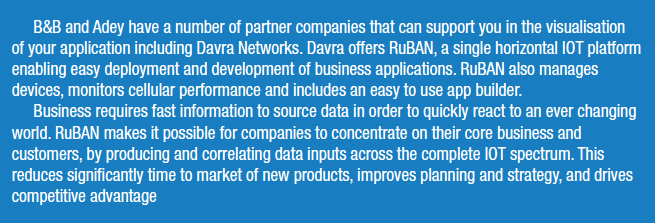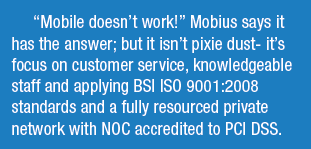
There are many considerations when your customers are commencing an M2M project as it is quite easy for engineers, technicians and operators to run away with wanting to connect, monitor and analyse everything - Power, RPMs, wastage through to hair colour, eye colour and other extremely useful things! However, what will they actually do with all this new information, how will it become useful and make their operations better? Before they are tempted into a world of snazzy cloud apps and pretty real-time graphs on handheld tablets, make sure they scrutinise exactly why they are changing their working practice and identify clear targets of what the project will enhance.
Here are some general tips for end users to consider...
Set Aims:
Is the project going to...increase management, visibility and control over remote ‘edge’ devices or improve efficiency in both operational practice and financial resources, will it reduce downtime and implement effective predictive maintenance or something completely different? Make sure their are measurable aims for the project before commencement - what will the return on investment be and how will this be measured; saving time, making more money, improving the working environment, increasing production, reducing downtime?
Understand the technology:
Don’t be blinded by science, buzz words and TLAs. Users should be fully aware of the following; what protocols are involved, what is the network size, remote monitoring options, power requirements/limitations, environment, potential physical and online security issues, deployment time, initial investment vs ongoing data and service costs.
Develop an understanding of what is possible and research similar M2M applications and case studies. A good partner will have many points of reference and be able to discuss various options to achieve the project goals.
Existing technologies:
In the consumer world, new technologies quickly drive older ones into obsolescence. That isn’t the case with industrial networks. The data networking infrastructure that is already in place is far too valuable and far too complex to be discarded - manufacturing plant, factory conveyor systems, wind turbines, vehicles etc. Therefore there will always be an element of integration with existing technologies often legacy devices and protocols – Non IP (e.g. Serial RS232,485/422).
Technology Partner?
How are the technological challenges going to be addressed? Selecting and working with technology partners such as Adey and B&B, will ensure resellers and users gain the integration experience and hardware to allow the application to communicate with whatever devices it needs to. Integrating alongside older technologies also means costs are better managed, and older devices simply phased out over time
Visualising the data:
Once everything is connected, then what? After all it’s only a series of 1’s & 0’s. If users have the expertise to create a beautiful ‘front-end’ interface, great! If not again find a technology partner who can help your customers reduce time to market and avoid any costly mistakes both functionally (future proofing and scalability) and financially.
Proof of Concept:
Complete a rigorous POC phase and plan all elements of the M2M project…
• Testing – Comparisons, Network Speeds, Transfers, Reliability
• Reports – Pre and Post application
• Evidence – Results, feedback (anecdotal/ factual)
• Budgets – Initial and Ongoing
• How to deploy – Pre-Configuration
• Maintenance – Remote Configuration
• Time to deploy
• Delivery – User competencies, training
• Training – Knowledge is power
• System failure - Plan B, failover
• Scalability - 1 - 1,000,000
There is always a danger to over-engineer an M2M application - as with all good projects stick to your plan and Keep it Simple!
As a large majority of IoT and M2M applications are almost dependent on Cellular technology, we thought we would ask our MVNO partner Mobius Networks to share some tips when using cellular to connect your devices!
Top Cellular Tips for M2M Applications
It is not uncommon for people to have a bad experience with cellular deployments, especially if the basic considerations are overlooked. More often than not some M2M projects start off with a system which is ‘good enough’ for mobile consumers (High Revenue / Lost Cost of Failure) and attempt to shoehorn it into industrial or Machine to Machine applications (Low Revenue / High Cost of Failure). Therefore result in sometimes problematic deployments and projects not hitting key criteria - resulting in bad press for this area of the M2M industry.
“The network is down!”, “The SIM must be faulty!”, “Mobile is rubbish!”
Here we highlight a few key points that you need to consider when using mobile in the M2M / IoT environment to avoid failure and have a positive headache-free experience.
Mobile black holes
When a device has been connected to a mobile network for a period of time the network may ‘sleep’ your radio layer on your device. On occasion the radio layer doesn’t wake, however because your device still has an IP layer it incorrectly believes it is still connected to the network and your packets go into a ‘black hole’. It can be very easy to avoid mobile black holes, just make sure that your hardware has the ability to manage its own connection.
What Hardware?
USB Dongles are popular because they are cheap, or free. But they do not manage their own connections, they are difficult to power cycle and they have they have poor RF performance. Dongles are designed for occasional use therefore used in an M2M (always on) environment the life expectancy is drastically reduced.
Talk to a suitable technology partner about the correct router hardware and security protocols instead. They can advise on dual SIM variants and other options that can enhance your connection and performance.
Antenna Considerations
Now that you have the appropriate cellular hardware, you need to get the right antennae. We get asked many times about using a directional antenna to get a better signal, and whilst this is true when your location is only served by a single cell site. Usually though the location is served by multiple cells, using a directional antenna is counter productive as your device cannot switch to another cell when conditions change, which they may do on a daily basis. Leaves, rain, cable length, a bus or a new building can all mean your directional antenna is pointing in the wrong direction.
High Cost of Failure?
If your system stops working for an hour what will that cost your company. What about if it stops for 24 hours or a week? If it does fail will you have to go to site or will you have to recover the device? These costs can be huge compared to the costs of the airtime and easily swamp any savings made by using cheap airtime and hardware.
Data Rounding
Be careful on data packages that ‘round-up’ bytes to the nearest Kilobyte or even Megabyte – costs can soon spiral out of control. Particularly important for large-scale, low-data applications like Telemetry.
Aggregated Billing
Imagine a situation where a company has 100 remote sites, each site consumes just less than 1MB per month on average; however some sites occasionally use 2MB and others only 0.5MB. To maximise ease of deployment and reduce any excess data charges consider a tariff that allows you to have 100 x 1MB SIMs which can all utilise a 100MB aggregated pool of data.
Accurate Test Environments
Perform proof of concepts in the most accurate conditions to the planned deployment. Slight changes in hardware (antennas, router operation), SIM type, location, connections (wired, Wi Fi) can have huge implications on the success of your deployment.
Security
Private APNs are often recommended. Using a Public IP SIM has some benefits for simple connectivity but also exposes your connection to excess data usage if for example someone finds your IP address on the internet and attacks your device. Your firewall may block traffic at the router stage; however your data usage will be increased significantly by the data being sent towards your router, across the connection initially.
Keep it Simple
IoT and M2M doesn’t have to be difficult - remember our philosophy, we are just connecting ‘things’ rather than ‘people’ to the internet and all the original rules apply in terms of reliability and security. To capitalise on the revenue opportunity you just need a good plan on how this fits with your existing offering, and do you have the right opportunities based in your existing customer base or is this a totally new market opportunity? Working with trusted partners in this market is equally acceptable, do you elect to ‘host’ M2M applications as part of an existing platform provision or outsource for example - do you provide the private APN for the ‘data airtime’ or partner with a Data MVNO, what value can your business bring to the end user? Consolidated billing for multiple services might be an example, integration to existing enterprise systems might just be another - the analyst’s agree this is the biggest obstacle to growth right now in the IoT landscape… your business might be the one to really capitalise on the bringing it all together for the end user - and my how the market and investors would love that!
Editors Comment
Where ever you look someone seems to be predicting big numbers regarding the size of the M2M market. Whichever set of figures you happen to follow there is no question that M2M technology is going to represent a huge part of our market at some stage in the near future. Getting your head around the applications of M2M solutions can be difficult for those not currently in that segment but once the depth of the opportunity is realised there is almost no vertical market untouched by the technology. I would like to think my crystal ball is better than most when it comes to technology but sometimes it’s hard to predict how markets are going to react. When this happens I turn my eyes and ears towards the ‘big boys’ out there to see how they are treating the market. So when Google bought up home smart metering company Nest for a massive $3.2bn, far and above what they were worth, it is a fairly good market indicator. Resellers need to ask themselves, can I afford to not be in this market?


